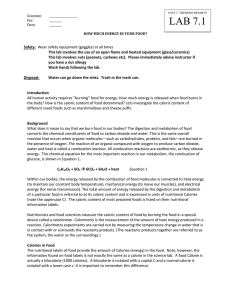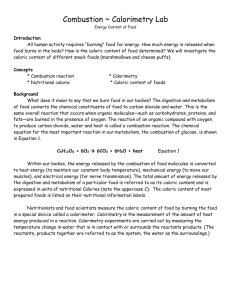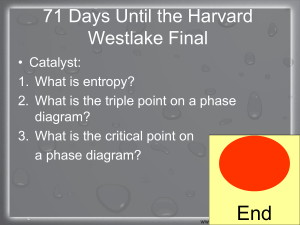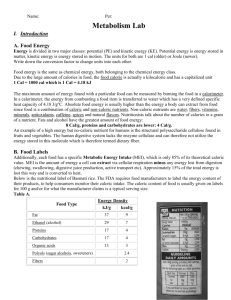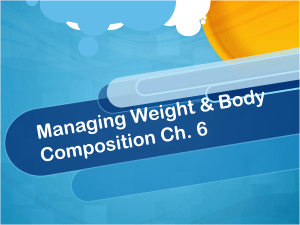Cheeto Calorimetry Lab
advertisement
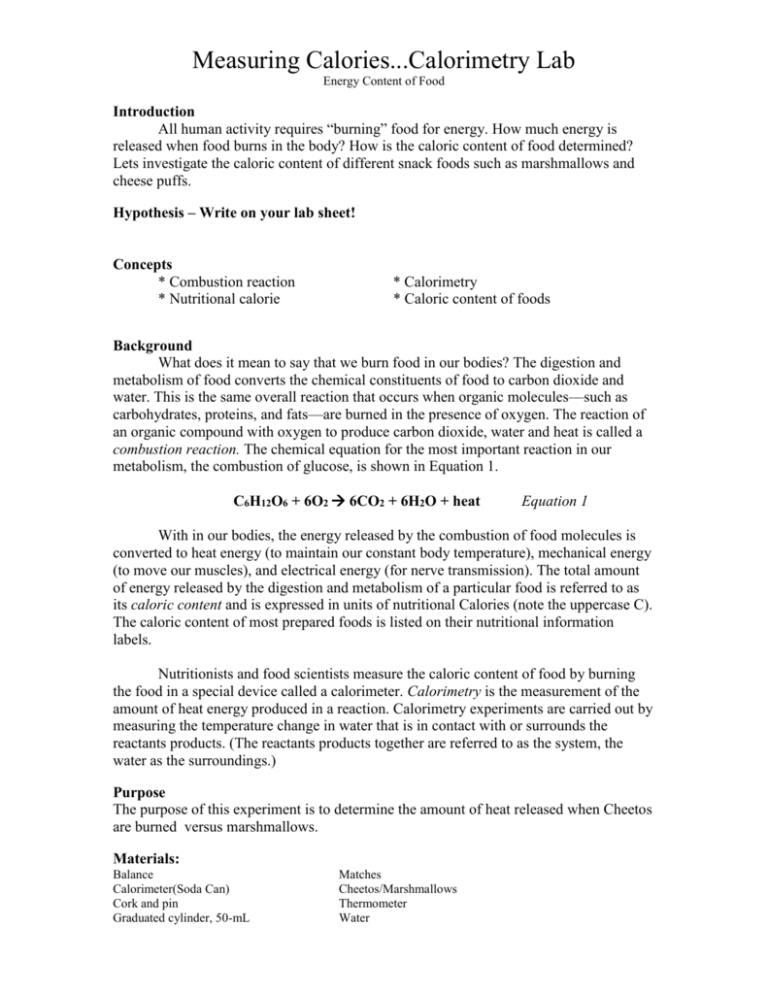
Measuring Calories...Calorimetry Lab Energy Content of Food Introduction All human activity requires “burning” food for energy. How much energy is released when food burns in the body? How is the caloric content of food determined? Lets investigate the caloric content of different snack foods such as marshmallows and cheese puffs. Hypothesis – Write on your lab sheet! Concepts * Combustion reaction * Nutritional calorie * Calorimetry * Caloric content of foods Background What does it mean to say that we burn food in our bodies? The digestion and metabolism of food converts the chemical constituents of food to carbon dioxide and water. This is the same overall reaction that occurs when organic molecules—such as carbohydrates, proteins, and fats—are burned in the presence of oxygen. The reaction of an organic compound with oxygen to produce carbon dioxide, water and heat is called a combustion reaction. The chemical equation for the most important reaction in our metabolism, the combustion of glucose, is shown in Equation 1. C6H12O6 + 6O2 6CO2 + 6H2O + heat Equation 1 With in our bodies, the energy released by the combustion of food molecules is converted to heat energy (to maintain our constant body temperature), mechanical energy (to move our muscles), and electrical energy (for nerve transmission). The total amount of energy released by the digestion and metabolism of a particular food is referred to as its caloric content and is expressed in units of nutritional Calories (note the uppercase C). The caloric content of most prepared foods is listed on their nutritional information labels. Nutritionists and food scientists measure the caloric content of food by burning the food in a special device called a calorimeter. Calorimetry is the measurement of the amount of heat energy produced in a reaction. Calorimetry experiments are carried out by measuring the temperature change in water that is in contact with or surrounds the reactants products. (The reactants products together are referred to as the system, the water as the surroundings.) Purpose The purpose of this experiment is to determine the amount of heat released when Cheetos are burned versus marshmallows. Materials: Balance Calorimeter(Soda Can) Cork and pin Graduated cylinder, 50-mL Matches Cheetos/Marshmallows Thermometer Water Procedure 1. Place a food sample on the food holder. Measure and record the combined mass of the food holder and sample. Place the food holder on a ring stand. 2. Obtain a clean, empty soda can. Measure and record its mass. 3. Add about 50 mL of tap water to the can and measure the combined mass of the can and water. 4. Bend the top tab on can up and slide a file through the hole. Suspend the can on a ring stand using a metal ring. Adjust the height of the can so that it is about 2.5 cm above the food holder. 5. Insert a thermometer into the can. Measure and record the initial temperature of the water. 6. Light the food sample and center it under the can. Allow the water to be heated until the food sample stops burning. Record the maximum (final) temperature of the water in the can. 7. Measure and record the final mass of the food holder and sample. 8. Clean the bottom of the can and remove any residue from the food holder. Repeat the procedure with a second food sample. Title: Think of a title for this lab Hypothesis: Which snack food do you think has more calories per gram and WHY? You may think about relative fat content vs. sugar (carbohydrate) content if that helps. Background: Look up information regarding nutritional Calories in relation to chemistry calories from class. Look up the calorie content (in Cal per gram) of different molecule types found in food such as fats, carbohydrates (sugars) and proteins. Discuss which of these 3 molecule types would be dominant in the food samples you chose based upon the ingredients listed. Procedure: Write down a step-by-step procedure in your own words and draw pictures to better explain how to set up the experiment. Experiment/Observations: FOOD SAMPLE DATA TABLE FOR DURING LAB INITIAL FINAL INITIAL T MASS MASS (Ti) oC (mi) g (mf) g of water FINAL T (Tf) oC of water DATA CALCULATIONS MASS ΔT o BURNED C of food of water Record the mass of water used in each of your can calorimeters each time: _____________ Remember that 1 ml of water weighs 1 g (density of water is 1g/ml) so you could try to keep it at 50.0mL each time for easier calculations. What is the specific heat (symbol cwater) of liquid water? ______________ Calculations and Analysis(POST LAB): Show your work for the DATA CALCULATIONS TABLE and for the following question in your lab write up. 1. Write down the Calories per serving, grams per serving and the amount of fats, carbohydrates and proteins in each of your food samples. 2. 3. Calculate the change in temperature for each sample. (T = Tf-Ti) Record it in your table. Use the heat equation to calculate the heat absorbed by the water in the calorimeter (thus the heat released by the food) for each food sample. Report the results in calories, kilocalories, and nutritional Calories. (q = mCT) (1000 cal = 1kcal = 1 nutritional Cal) A. Food Sample 1 in cal, kcal and Cal B. Food Sample 2 in cal, kcal, and Cal 4. Subtract the final mass of the food sample and holder from the initial mass to determine the mass in grams of the food sample that burned in each experiment. (mass burned = mi-mf) Record it in your table. 5. Use the results from #3 and #4 to calculate the energy content (fuel value) of the food sample in of Cal/g. (This just requires taking your Calories produced divided by mass of sample burned). 6. Calculate the Cal/gram for each of your food samples from your experimental data AND calculate the Cal/gram using the nutritional label information recorded from part 1. units Conclusion and Application: Accept or Reject Hypothesis. State your final conclusions on Cal/gram in each food sample (..what was learned). Which snack food has the higher energy content? Comparing the nutritional labels of the two foods, hypothesize about why you think this is the case. Address the major sources of error in this experiment. Do you think your results are off on the high or the low side? Justify your choice. Suggest modifications to get better results. Now solved the problems below as an application of what was learned in the lab. Application Problems: SHOW YOUR WORK! 1. A candy bar has a total mass of 75.0 grams. In a calorimetry experiment, a 1.0-g sample of this candy bar was burned in a calorimeter surrounded by 1000 g of water. The temperature of the water in contact with the burning candy bar was measured and found to increase from an initial temperature of 21.2oC to a final temperature of 24.3oC. a. Calculate the amount of heat in calories released when the 1.0-g sample burned. b. Convert the heat in calories to nutritional Calories and then calculate the energy content (fuel value) in Cal/g. c. Calculate the total caloric content of the candy bar in Calories. 2. Attach two nutritional labels from one of your favorite snack foods. Report their total caloric content (in Calories) and calculate their fuel value in Cal/g. 3. Many diet crazes come along claiming they have the secret to weight loss. Atkins Diet. Research a popular diet (such as Atkins Diet, South Beach Diet, the Zone Diet, etc) and explain what this diet involves and give two advantages and two disadvantages. Cheetos Label Marshmallow Label
